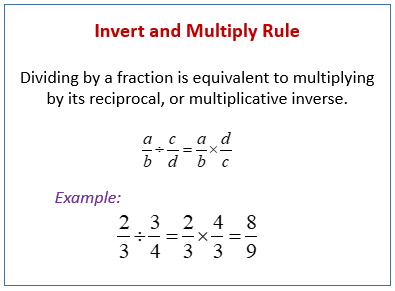Visual Fraction Models and Equations
Videos and solutions to help Grade 6 students connect models of fractions to multiplication through the use of multiplicative inverses as they are represented in models.
Related Topics:
Lesson Plans and Worksheets for Grade 6
Lesson Plans and Worksheets for all Grades
More Lessons for Grade 6
Common Core For Grade 6
New York State Common Core Math Grade 6, Module 2, Lesson 7
Lesson 7 Student Outcomes
- Students formally connect models of fractions to multiplication through the use of multiplicative inverses as they are represented in models.
Lesson 7 Summary
Connecting models of fraction division to multiplication through the use of reciprocals helps in understanding the “invert and multiply” rule.
The following diagram shows the Invert and Multiply Rule. Scroll down the page for more examples and solutions.

Lesson Notes
The reciprocal, or inverse, of a fraction is the fraction made by interchanging the numerator and denominator.
Example 1
3/4 ÷ 2/5
Exercise 1
1/4 ÷ 2/3
Exercise 2
2/3 ÷ 3/4
Classwork
Opening
Multiplicative Inverses: Two numbers whose product is 1 are multiplicative inverses of one another.
Example 1
3/4 ÷ 2/5
Exercise 1
1/4 ÷ 2/3
Exercise 2
2/3 ÷ 3/4
Lesson 7 Problem Set
Invert and multiply to divide.
- a. 2/3 ÷ 1/4
b. 2/3 ÷ 4
c. 4 ÷ 2/3 - a. 1/3 ÷ 1/4
b. 1/8 ÷ 3/4
c. 9/4 ÷ 6/5 - a. 2/3 ÷ 3/4
b. 3/5 ÷ 3/2
c. 22/4 ÷ 2/5 - Summer used 2/5 of her ground beef to make burgers. If she used 3/4 pounds of beef, how much beef did she have at first?
- Alistair has 5 half-pound chocolate bars. It takes 1 1/2 pounds of chocolate, broken into chunks, to make a batch of cookies. How many batches can Alistair make with the chocolate he has on hand? 6 Draw a model that shows 2/5÷1/3. Find the answer as well.
- Draw a model that shows 3/4÷1/2. Find the answer as well.
Lesson 6 Problem Set Sample Solution
- Write a partitive division story problem for 45 ÷ 3/5
- Write a partitive division story problem for 100 ÷ 2/5
Lesson 7 Student Outcomes
Students formally connect models of fractions to multiplication through the use of multiplicative inverses as they are represented in models.
The reciprocal, or inverse, of a fraction is the fraction made by interchanging the numerator and denominator.
Two numbers whose product is 1 are multiplicative inverses.
Example 1:
3/4 ÷ 2/5
Lesson 8 Student Outcomes
Students divide fractions by mixed numbers by first converting the mixed numbers into a fraction with a value larger than one.
Students use equations to find quotients.
Example 1: Introduction to Calculating the Quotient of a Mixed Number and a Fraction
Carli has 4 1/2 walls left to paint in order for all the bedrooms in her house to have the same color paint. However, she has used almost all of her paint and only has 5/6 of a gallon left. How much paint can she use on each wall in order to have enough to paint the remaining walls?
Calculate the quotient. 2/5 ÷ 3/4
Lesson 1 to Lesson 8 Review
Try out our new and fun Fraction Concoction Game.
Add and subtract fractions to make exciting fraction concoctions following a recipe. There are four levels of difficulty: Easy, medium, hard and insane. Practice the basics of fraction addition and subtraction or challenge yourself with the insane level.

We welcome your feedback, comments and questions about this site or page. Please submit your feedback or enquiries via our Feedback page.